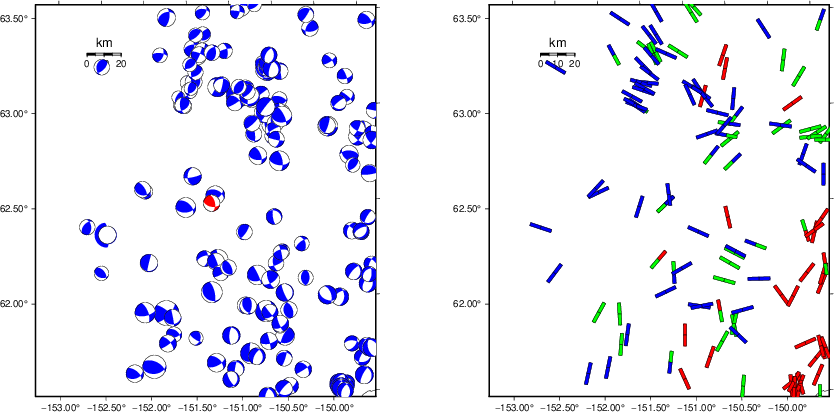Location
Location ANSS
The ANSS event ID is ak016dljpinx and the event page is at
https://earthquake.usgs.gov/earthquakes/eventpage/ak016dljpinx/executive.
2016/10/22 01:06:33 62.515 -151.274 99.8 4.1 Alaska
Focal Mechanism
USGS/SLU Moment Tensor Solution
ENS 2016/10/22 01:06:33:0 62.51 -151.27 99.8 4.1 Alaska
Stations used:
AK.BPAW AK.BWN AK.DHY AK.KLU AK.KNK AK.KTH AK.MCK AK.NEA2
AK.RC01 AK.SAW AK.SCM AK.SKN AK.TRF AK.WRH AT.PMR AT.TTA
TA.I21K TA.I23K TA.L19K TA.M19K TA.M20K TA.N19K
Filtering commands used:
cut o DIST/3.6 -30 o DIST/3.6 +50
rtr
taper w 0.1
hp c 0.03 n 3
lp c 0.10 n 3
br c 0.12 0.25 n 4 p 2
Best Fitting Double Couple
Mo = 1.60e+22 dyne-cm
Mw = 4.07
Z = 102 km
Plane Strike Dip Rake
NP1 349 58 138
NP2 105 55 40
Principal Axes:
Axis Value Plunge Azimuth
T 1.60e+22 51 315
N 0.00e+00 39 139
P -1.60e+22 2 48
Moment Tensor: (dyne-cm)
Component Value
Mxx -4.01e+21
Mxy -1.11e+22
Mxz 5.23e+21
Myy -5.68e+21
Myz -5.89e+21
Mzz 9.68e+21
#####---------
###########-----------
################-----------
##################---------- P
#####################--------- -
#######################-------------
########### ###########-------------
############ T ############-------------
############ ############-------------
--###########################-------------
---##########################-------------
-----########################-------------
-------######################-------------
---------####################-----------
------------#################----------#
----------------###########-------####
--------------------------##########
-------------------------#########
----------------------########
---------------------#######
-----------------#####
------------##
Global CMT Convention Moment Tensor:
R T P
9.68e+21 5.23e+21 5.89e+21
5.23e+21 -4.01e+21 1.11e+22
5.89e+21 1.11e+22 -5.68e+21
Details of the solution is found at
http://www.eas.slu.edu/eqc/eqc_mt/MECH.NA/20161022010633/index.html
|
Preferred Solution
The preferred solution from an analysis of the surface-wave spectral amplitude radiation pattern, waveform inversion or first motion observations is
STK = 105
DIP = 55
RAKE = 40
MW = 4.07
HS = 102.0
The NDK file is 20161022010633.ndk
The waveform inversion is preferred.
Magnitudes
Given the availability of digital waveforms for determination of the moment tensor, this section documents the added processing leading to mLg, if appropriate to the region, and ML by application of the respective IASPEI formulae. As a research study, the linear distance term of the IASPEI formula
for ML is adjusted to remove a linear distance trend in residuals to give a regionally defined ML. The defined ML uses horizontal component recordings, but the same procedure is applied to the vertical components since there may be some interest in vertical component ground motions. Residual plots versus distance may indicate interesting features of ground motion scaling in some distance ranges. A residual plot of the regionalized magnitude is given as a function of distance and azimuth, since data sets may transcend different wave propagation provinces.
ML Magnitude

Left: ML computed using the IASPEI formula for Horizontal components. Center: ML residuals computed using a modified IASPEI formula that accounts for path specific attenuation; the values used for the trimmed mean are indicated. The ML relation used for each figure is given at the bottom of each plot.
Right: Residuals from new relation as a function of distance and azimuth.

Left: ML computed using the IASPEI formula for Vertical components (research). Center: ML residuals computed using a modified IASPEI formula that accounts for path specific attenuation; the values used for the trimmed mean are indicated. The ML relation used for each figure is given at the bottom of each plot.
Right: Residuals from new relation as a function of distance and azimuth.
Context
The left panel of the next figure presents the focal mechanism for this earthquake (red) in the context of other nearby events (blue) in the SLU Moment Tensor Catalog. The right panel shows the inferred direction of maximum compressive stress and the type of faulting (green is strike-slip, red is normal, blue is thrust; oblique is shown by a combination of colors). Thus context plot is useful for assessing the appropriateness of the moment tensor of this event.
Waveform Inversion using wvfgrd96
The focal mechanism was determined using broadband seismic waveforms. The location of the event (star) and the
stations used for (red) the waveform inversion are shown in the next figure.
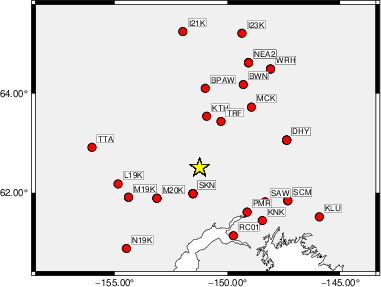
|
|
Location of broadband stations used for waveform inversion
|
The program wvfgrd96 was used with good traces observed at short distance to determine the focal mechanism, depth and seismic moment. This technique requires a high quality signal and well determined velocity model for the Green's functions. To the extent that these are the quality data, this type of mechanism should be preferred over the radiation pattern technique which requires the separate step of defining the pressure and tension quadrants and the correct strike.
The observed and predicted traces are filtered using the following gsac commands:
cut o DIST/3.6 -30 o DIST/3.6 +50
rtr
taper w 0.1
hp c 0.03 n 3
lp c 0.10 n 3
br c 0.12 0.25 n 4 p 2
The results of this grid search are as follow:
DEPTH STK DIP RAKE MW FIT
WVFGRD96 2.0 170 60 -30 3.26 0.3508
WVFGRD96 4.0 0 45 -5 3.36 0.3536
WVFGRD96 6.0 275 90 -50 3.39 0.3919
WVFGRD96 8.0 320 40 -85 3.53 0.4288
WVFGRD96 10.0 155 50 -65 3.51 0.4221
WVFGRD96 12.0 105 65 45 3.48 0.4276
WVFGRD96 14.0 100 80 40 3.49 0.4351
WVFGRD96 16.0 100 80 40 3.51 0.4415
WVFGRD96 18.0 100 80 40 3.53 0.4451
WVFGRD96 20.0 100 80 40 3.55 0.4460
WVFGRD96 22.0 100 80 40 3.58 0.4427
WVFGRD96 24.0 275 80 -45 3.60 0.4395
WVFGRD96 26.0 275 80 -45 3.62 0.4432
WVFGRD96 28.0 275 80 -45 3.65 0.4446
WVFGRD96 30.0 270 80 -45 3.67 0.4467
WVFGRD96 32.0 270 80 -45 3.69 0.4504
WVFGRD96 34.0 270 80 -45 3.71 0.4529
WVFGRD96 36.0 270 75 -45 3.74 0.4563
WVFGRD96 38.0 275 85 -35 3.75 0.4683
WVFGRD96 40.0 95 90 45 3.84 0.4816
WVFGRD96 42.0 95 80 40 3.85 0.4951
WVFGRD96 44.0 95 75 40 3.87 0.5124
WVFGRD96 46.0 95 75 40 3.88 0.5249
WVFGRD96 48.0 100 70 40 3.89 0.5379
WVFGRD96 50.0 100 60 40 3.91 0.5535
WVFGRD96 52.0 105 55 45 3.92 0.5696
WVFGRD96 54.0 105 55 45 3.94 0.5851
WVFGRD96 56.0 100 55 40 3.95 0.6001
WVFGRD96 58.0 100 55 40 3.96 0.6135
WVFGRD96 60.0 100 55 40 3.97 0.6238
WVFGRD96 62.0 100 55 40 3.97 0.6321
WVFGRD96 64.0 100 55 35 3.98 0.6388
WVFGRD96 66.0 100 50 35 3.99 0.6483
WVFGRD96 68.0 100 50 35 4.00 0.6575
WVFGRD96 70.0 100 50 35 4.00 0.6662
WVFGRD96 72.0 100 50 35 4.01 0.6733
WVFGRD96 74.0 100 50 35 4.01 0.6827
WVFGRD96 76.0 100 55 40 4.02 0.6933
WVFGRD96 78.0 100 55 40 4.02 0.7036
WVFGRD96 80.0 100 55 40 4.03 0.7117
WVFGRD96 82.0 110 50 40 4.03 0.7193
WVFGRD96 84.0 110 50 40 4.04 0.7300
WVFGRD96 86.0 110 50 40 4.04 0.7381
WVFGRD96 88.0 110 50 40 4.05 0.7426
WVFGRD96 90.0 110 50 40 4.05 0.7494
WVFGRD96 92.0 110 50 40 4.05 0.7548
WVFGRD96 94.0 105 55 40 4.06 0.7561
WVFGRD96 96.0 105 55 40 4.06 0.7611
WVFGRD96 98.0 105 55 40 4.07 0.7637
WVFGRD96 100.0 105 55 40 4.07 0.7640
WVFGRD96 102.0 105 55 40 4.07 0.7668
WVFGRD96 104.0 105 55 40 4.08 0.7647
WVFGRD96 106.0 105 50 35 4.08 0.7656
WVFGRD96 108.0 105 50 35 4.08 0.7640
WVFGRD96 110.0 105 50 35 4.08 0.7623
WVFGRD96 112.0 105 50 35 4.08 0.7595
WVFGRD96 114.0 105 50 35 4.09 0.7559
WVFGRD96 116.0 105 50 35 4.09 0.7533
WVFGRD96 118.0 105 50 35 4.09 0.7490
The best solution is
WVFGRD96 102.0 105 55 40 4.07 0.7668
The mechanism corresponding to the best fit is
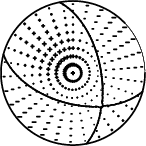
|
|
Figure 1. Waveform inversion focal mechanism
|
The best fit as a function of depth is given in the following figure:
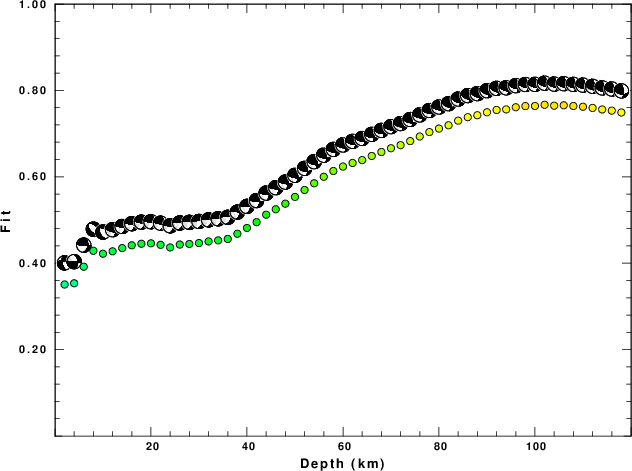
|
|
Figure 2. Depth sensitivity for waveform mechanism
|
The comparison of the observed and predicted waveforms is given in the next figure. The red traces are the observed and the blue are the predicted.
Each observed-predicted component is plotted to the same scale and peak amplitudes are indicated by the numbers to the left of each trace. A pair of numbers is given in black at the right of each predicted traces. The upper number it the time shift required for maximum correlation between the observed and predicted traces. This time shift is required because the synthetics are not computed at exactly the same distance as the observed, the velocity model used in the predictions may not be perfect and the epicentral parameters may be be off.
A positive time shift indicates that the prediction is too fast and should be delayed to match the observed trace (shift to the right in this figure). A negative value indicates that the prediction is too slow. The lower number gives the percentage of variance reduction to characterize the individual goodness of fit (100% indicates a perfect fit).
The bandpass filter used in the processing and for the display was
cut o DIST/3.6 -30 o DIST/3.6 +50
rtr
taper w 0.1
hp c 0.03 n 3
lp c 0.10 n 3
br c 0.12 0.25 n 4 p 2
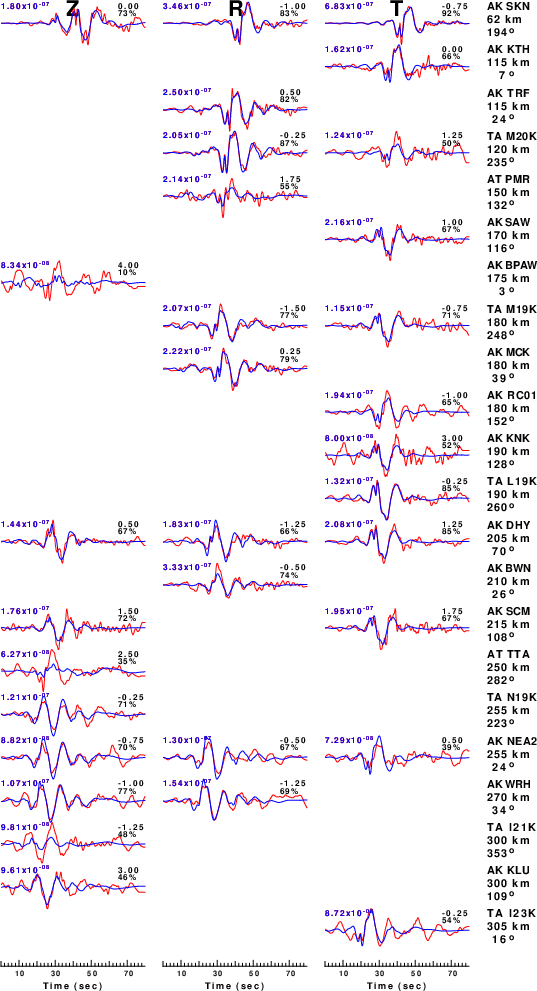
|
|
Figure 3. Waveform comparison for selected depth. Red: observed; Blue - predicted. The time shift with respect to the model prediction is indicated. The percent of fit is also indicated. The time scale is relative to the first trace sample.
|
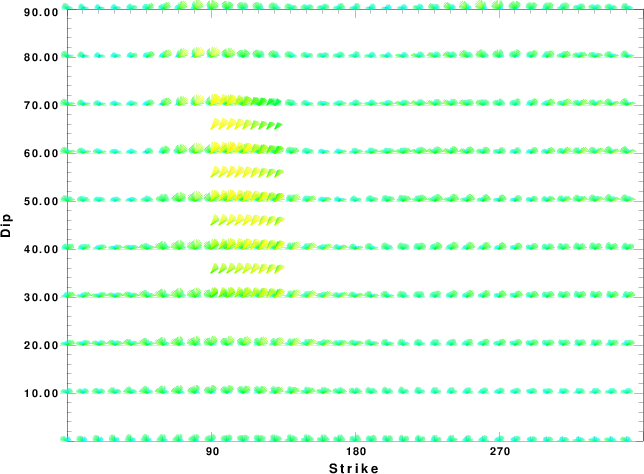
|
|
Focal mechanism sensitivity at the preferred depth. The red color indicates a very good fit to the waveforms.
Each solution is plotted as a vector at a given value of strike and dip with the angle of the vector representing the rake angle, measured, with respect to the upward vertical (N) in the figure.
|
A check on the assumed source location is possible by looking at the time shifts between the observed and predicted traces. The time shifts for waveform matching arise for several reasons:
- The origin time and epicentral distance are incorrect
- The velocity model used for the inversion is incorrect
- The velocity model used to define the P-arrival time is not the
same as the velocity model used for the waveform inversion
(assuming that the initial trace alignment is based on the
P arrival time)
Assuming only a mislocation, the time shifts are fit to a functional form:
Time_shift = A + B cos Azimuth + C Sin Azimuth
The time shifts for this inversion lead to the next figure:
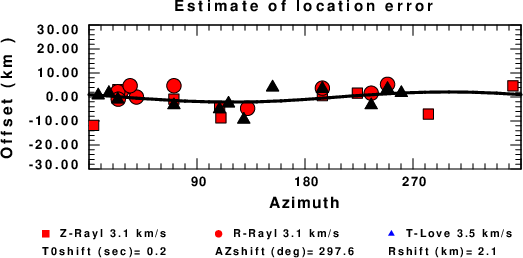
The derived shift in origin time and epicentral coordinates are given at the bottom of the figure.
Velocity Model
The WUS.model used for the waveform synthetic seismograms and for the surface wave eigenfunctions and dispersion is as follows
(The format is in the model96 format of Computer Programs in Seismology).
MODEL.01
Model after 8 iterations
ISOTROPIC
KGS
FLAT EARTH
1-D
CONSTANT VELOCITY
LINE08
LINE09
LINE10
LINE11
H(KM) VP(KM/S) VS(KM/S) RHO(GM/CC) QP QS ETAP ETAS FREFP FREFS
1.9000 3.4065 2.0089 2.2150 0.302E-02 0.679E-02 0.00 0.00 1.00 1.00
6.1000 5.5445 3.2953 2.6089 0.349E-02 0.784E-02 0.00 0.00 1.00 1.00
13.0000 6.2708 3.7396 2.7812 0.212E-02 0.476E-02 0.00 0.00 1.00 1.00
19.0000 6.4075 3.7680 2.8223 0.111E-02 0.249E-02 0.00 0.00 1.00 1.00
0.0000 7.9000 4.6200 3.2760 0.164E-10 0.370E-10 0.00 0.00 1.00 1.00
Last Changed Fri Apr 26 10:34:24 PM CDT 2024


